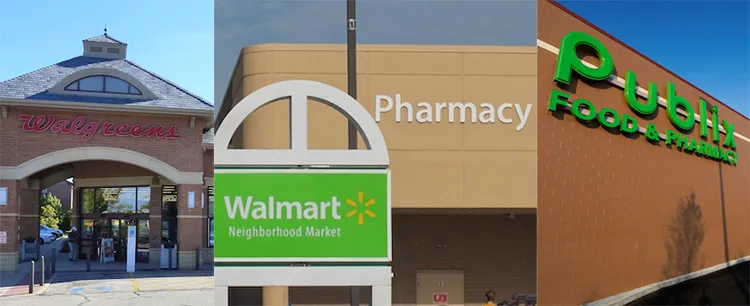
NEW YORK — Competition remains fierce in the chain pharmacy industry, albeit with a decreasing number of players.
If the pending acquisition of Rite Aid Corp. by Walgreens Boots Alliance Inc. goes through, the field will diminish dramatically, especially in major metropolitan areas. Depending on the number of stores WBA divests to meet antitrust requirements, the pickup would move Walgreens ahead of CVS Pharmacy into first place in the New York City, Philadelphia, Detroit, Baltimore-Towson, and San Jose-Sunnyvale-Santa Clara markets.
Rite Aid’s market leadership will be picked up by Walgreens in Pittsburgh; Buffalo-Niagara Falls, N.Y.; Rochester and Syracuse, N.Y.; Salisbury, Md.-southern Delaware; Canton-Massillon, Ohio; and Flint, Mich.
Fitch Ratings said Walgreens commands one-fifth of the U.S. prescription market, while Rite Aid has a 6% share. Besides bringing procurement and cost structure benefits from larger scale, the merger would significantly expand WBA’s market reach, Fitch noted.
Walgreens, which already has outlets in every state and Washington, D.C., has said the acquisition will fill gaps in its operating area in the Northeast and Southern California. Walgreens has 8,173 stores, including outlets in Puerto Rico and the U.S. Virgin Islands, while Rite Aid operates 4,560 stores in 31 states and the District of Columbia. The Northeast and Mid-Atlantic regions look to be where Rite Aid will bring the biggest benefit in coverage.
While the conventional chain drug industry may well become a two-horse race, retailers from other trade classes have staked a claim to drug store category sales in various markets.
Walmart, for example, holds one of the top three places in drug store sales in regions from Dallas-Fort Worth to Myrtle Beach, S.C. Grocers in the fray include Publix Super Markets Inc., which is No. 3 in Miami-Fort Lauderdale. Giant Eagle is third in its home base of Pittsburgh, while H-E-B holds that spot in San Antonio, its home market. Likewise Kroger Co. is No. 3 in its home base of Cincinnati. Hy-Vee Inc., which operates supermarkets with pharmacies and freestanding drug stores, is in third place in the Des Moines area, where it is based.
Among regional drug chains, Bartell Drugs is tied for second in Seattle-Tacoma-Bellevue with Rite Aid, while Discount Drug Mart retains the No. 3 spot in Cleveland-Elyria-Mentor, and Kinney Drug is No. 2 in Syracuse.
Although supermarkets and mass merchandisers may not seem, at first glance, like direct competition for drug chains, a closer look reveals a continued blurring of the trade classes.
In some cases the homogenization is being fomented by drug chains, as with CVS’ focus on healthy food. Larry Merlo, CVS Health’s president and chief executive officer, said over the summer that “following last year’s health and beauty enhancements across thousands of stores, we continue to scale our healthy food selection.”
Walmart, meanwhile, has made pharmacy and related categories a priority. The retailer’s commitment to and focus on health care comes from the top, says George Riedl, president of Walmart’s health and wellness business. Everyone from president and CEO Doug McMillon on down realizes that, with the size and scale of Walmart, the company can make a significant impact on the well-being of patients and customers, Riedl said.
At the same time, health care presents a major business opportunity, he added. “Health and wellness can certainly be a needle mover for the company in the future.”
For his part, Kroger CEO Rodney McMullen said this year, “We’re in the food business, and we’re in the health and wellness business.” He said those areas will be a focus of company efforts to get “a deeper and better connection with our customers.
On the expansion front, Kroger purchased Roundy’s Inc. in 2015, getting 151 stores and 101 pharmacies in new markets — including Milwaukee and Madison, Wis. — under the Pick ’n Save, Copps and Metro Market banners. The merger also expanded Kroger’s presence in the Chicago area via 34 stores operating under the Mariano’s banner.
And at Hy-Vee, pharmacy complements other health and wellness offerings, including nutritional advice and clinics, says senior vice president of pharmacy operations Kristin Williams. In short, stores are one-stop shops for customers’ well-being, she says.
Healthful food choices are integral to treatment and preventive care, according to Williams. Among its pharmacists, in-store dietitians, health concierges, chefs and clinics, Hy-Vee allows customers to easily pursue care for a variety of medical conditions or get guidance on how to achieve their personal health goals, she adds.
Among regional drug chains, Bartell Drugs last month unveiled its newest location — its 65th — in Seattle’s Chinatown-International District (CID). And as Bartell has expanded, it has continued to refine its store format with engaging presentations in such areas as consumables, beauty care, and health and wellness products, along with its pharmacy.







